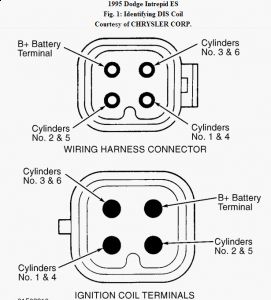No-Start Test 1. Ensure battery is fully charged (at least 12.6 volts). Disconnect coil electrical connector. Connect a test light to coil electrical connector battery voltage terminal. See Fig. 1 . 2. Turn ignition switch to ON position. Test light should momentarily flash on and off. If test light does not momentarily flash on and off, ASD relay has failed to energize. Check ASD relay and related circuits. See appropriate TESTS W/CODES - 3.3L article. 3. If test light momentarily flashes on and off, PCM has grounded Auto Shutdown (ASD) relay. Go to next step. DO NOT turn ignition off at this time. 4. Crank engine, and observe test light. If ignition was turned off at end of step 3), turn ignition switch to ON position, wait for test light to flash once, and then crank engine. 5. If test light momentarily flashes during cranking, engine controller is not receiving a camshaft sensor signal. Check camshaft sensor and related sensor circuits. See TESTS W/CODES - 3.3L article. 6. If test light does not flash during cranking, disconnect camshaft sensor connector. Turn ignition switch to OFF and then to ON position. Wait for test light to momentarily flash once, and then crank engine. 7. If test light momentarily flashes, camshaft sensor is shorted and must be replaced. If test light does not flash, no-start condition is caused by problem in crankshaft or camshaft sensor 9-volt power supply circuit or by crankshaft sensor 5-volt output or ground circuits. See TESTS W/CODES - 3.3L article. Ignition Coil Resistance Test 1. Disconnect ignition coil harness connector. Measure primary coil resistance between battery voltage terminal and pin corresponding to cylinder(s) in question. See Fig. 1 . 2. Measure secondary coil resistance between coil towers of grouped cylinders; No. 1 and 4, 2 and 5, and 3 and 6. Replace ignition coil if primary/secondary coil resistance is not as specified. See IGNITION COIL RESISTANCE table under IGNITION COIL.


SPONSORED LINKS
Saturday, April 18th, 2009 AT 10:15 AM






